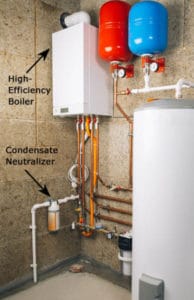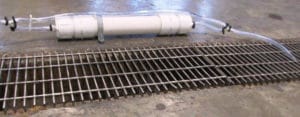Q: I have a century-old home with copper and cast-iron drain pipes. I recently installed a high-efficiency furnace but learned the condensate may be corrosive to the drain pipes.
I am wondering what pH level can harm the drain pipes. Also should I filter the water though a material such as limestone to reduce the pH. Would this an effective solution for treating the water before going down the drain,. I currently have a condensate pump that pumps it to the laundry sink. Thanks for your time. — Adam
A: Water with a pH below 7 is generally considered acidic and below 6.5, water is corrosive to most materials. The EPA recommends that household water be between 6.5 and 8.5 for health reasons, not because of damage to pipes.

Condensate from a high-efficiency furnace typically has a pH of about 5.0, but can range from 3.5 to 6.5. It’s important to note that pH is a logarithmic scale, so pH 5 water is 10 times more acidic than pH6.
If the water sits in a trap and evaporates, the acidity and corrosive effect will increase. In older homes a whole-house trap might be buried in the floor and the main sewer line to the street is most likely cast iron, even if modern PVC drains have been installed in the house.
In a 100-year-old home, it’s likely that the drain pipes already have considerable corrosion, so you don’t want to add to the problem. Cast-iron pipes tend to corrode from the inside out, so what appears a small rust spot or rusted seam on the exterior can be a sign of imminent failure. In some cases you can push a screwdriver right through the pipe at the visible rust spot.
Cast iron is about 10 times more vulnerable to corrosion than copper, so corrosion from condensate can rapidly destroy cast-iron drain pipes. While corrosion of copper is slower, it still occurs over time. PVC is immune to corrosion from acidity, but some plastics such as ABS are vulnerable.
For example, a house I owned for several years had well water with a pH of 6.3. This caused blue stains on all plumbing fixtures from copper leached from the inside of the water-supply pipes. Eventually, acidic water will lead to pinhole leaks in the copper pipes. How many years this will take depends on a lot of factors and is difficult to predict.

Adding a condensate neutralizer to the drain line from the furnace is a good idea, and is required by some plumbing codes (but not always enforced). There are a number of commercial neutralizing kits on the market. Most are pretty simple inline filters with a neutralizing agent such as crushed limestone that needs to be replenished periodically. Just search the web for “condensate neutralizer kit” to see what’s available.
Manufacturers recommend that you test the pH of the filtered water every month for the first year to determine how often you need to add new filter media. The larger the filter, the less often it will need to be replenished.
For safety, it is important to plumb a bypass line in case the filter gets blocked. This can happen with some types of media when left unattended for too long. It can harden into a block. Also, all high-efficiency appliances have internal traps in the condensate line to prevent flue gas from escaping out the pipe. This should be checked during servicing.
In warm climates where high-efficiency gas appliances are less common, the condensate drain is often routed directly to the outdoors. Other than stains on the brick or siding, this usually works well unless a cold snap hits. Then the condensate line can freeze and shut down the furnace. People have tried a number of remedies – increasing the diameter of the drain, insulating the drain, or – if all else fails – adding an electric heat tape to the pipe which kicks on when the weather falls below freezing.
One other thing to consider in an older home is the effect on the chimney flue of switching to a side-vented furnace or boiler. In cold weather, the older, inefficient furnace or boiler kept the flue warm. This minimized condensation of corrosive exhaust gases on the inside walls of the flue.
If you have gas-fired water heater sharing the same flue, the cooler flue will be now subject to increased damage from corrosion. This is mainly a problem with older clay-tile or unlined brick flues. A bigger concern with oversized flues is backdrafting, particularly if you’ve weatherized the house. If you have a gas-fired water heater, check with an HVAC contractor to make sure the flue size is matched to the appliance.
You can read more at these links: Acidic Well Water Acid Neutralizing Filters
— Steve Bliss, Editor & Publisher, BuidingAdvisor.com
Adam says
Thanks so much for your detailed reply.
I have been researching this for a while but could not come up with actual pH numbers to be wary of, though ironically when i searched for can too high pH harm copper then i finally found yesterday how low could also damage it (the 6.5 you mentioned).
I’m in Canada and while high efficiency natural gas furnaces are required by law neutralizers are hard to find and need to be imported. In my case the condensate pump sends it to the laundry sink that has copper piping going through the wall to outside to the city wastewater. Once it exits the house i don’t know if it stays copper, becomes cast iron (the kitchen/toilet is cast iron) or is clay but either way i am wanting to neutralize it. The original drain plain from 1914 shows two runs to the city drain, one laundry sink and second everything else.
It does sit in the trap right under the laundry sink because the laundry sink is unvented (i am planning on adding an Air Admittance valve when i replace the laundry sink hopefully this year) but have considered making my own neutralizer by buying a bag of construction limestone from the local big box store and running the condensate to a 2L pop bottle filled with limestone then draining to the laundry sink which i can check on and replenish as needed hopefully a couple times a year or less (40K furnace with 25K peak load, probably not need doing often).
In the interim i have been collecting the condensate in a bucket, watering it down, draining it then following with a couple liters of water.
My concerns are will the limestone get to pH of 7 and if higher could it get high enough to be harmful on the other side of the equation since this would be a DIY solution. I am looking for local pH litmus paper so i can test before and after.
Mark says
Adam, you don’t to worry about the limestone making the water corrosive on the other side (basic vs. acidic). Limestone isn’t corrosive itself–it acts more like a buffer agent (like baking soda). On the other hand, I did read something on the web about limestone or marble chips becoming less effective as time goes on as the reaction with the acidic condensate creates a coating on the rock making it less effective (search for “JJM Boiler white paper”).
That made sense to me as I grew up in the coal-mining area of Pennsylvania and there were many small streams damaged by acidic drainage from coal mines. One of the remedies was to run water through drums of limestone rocks. Often they would put some kind of rotator on the drum to keep the coating broken off the limestone. Of course, if you are going to check the pH of your inflow and outflow on a regular basis, it would tell you if you need to change your rock. I’m more or less in the same boat as you: 1925 house with cast iron and clay drain pipes and I don’t want to run my condensate line to the outside anymore. Good luck!